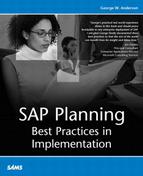The SAP Data Center “Big Picture”
From a “big picture” perspective, you need to ensure that no detail is overlooked when planning for your SAP Data Center facility or facilities. Availability, after all, is all about details. Each layer in the SAP Solution Stack presents you with single-point-of-failure challenges; each layer must therefore be thoughtfully considered with an eye toward eliminating these SPOFs, or at least noting and mitigating risk to the point where such risk becomes financially acceptable.
First Things First—Standardization
Before we dive into identifying and addressing single points of failure common to SAP Data Center designs and implementation, it first makes sense to discuss the role of standards and standardization in your data center. Standards impact everything. Fortunately, taking a close look at standards early in the SAP Data Center planning process forces you to think ahead, and ultimately avoid many pitfalls potentially lurking in the future. Consider the following:
Server naming conventions must be descriptive enough to promote manageability, but short enough to be technically supported by the particular SAP component version (and any other applications that might need to reference this name, including systems management applications like HP Openview or BMC Patrol).
IP naming conventions should help identify what type of server network connection is being made. For example, standards that help to identify public, private, clustered, and internal/other network connections are quite prevalent in the world of SAP infrastructure.
Disk naming (and drive letter, for Windows 2000/NT) conventions should be published and leveraged for consistency. Such consistency by its very nature impacts availability as well, as the chance of someone “accidentally” bringing a disk resource offline is less likely to occur when the disk name or disk drive letter for the database (for example) tends to be the same throughout the SAP landscape.
Even something as simple as color-coding network cables and power cables can improve system availability. Similar to IP naming conventions, a good color-coding scheme helps avoid unplanned downtime due to inadvertently uncabling or miscabling a vital network or power connection. I have witnessed companies leveraging factors other than simply color, too; the number and thickness of bands in a cable, and even the cable thickness itself can also be used to differentiate otherwise similar cables.
Standard “high-availability server configurations” are normal in most SAP shops. This usually equates to servers configured with redundant power supplies, fans, power distribution units, processors, RAID-protected disk drives, RAID or ECC-protected RAM, network cards, and so on, in a server cluster configuration with dual-host bus adapters in each server.
As with standard highly available server configurations, most SAP shops also promote an equivalent “high-availability disk subsystem.” This usually involves a standard frame or disk chassis, standard drive size (in example, 36GB 15,000 RPM 1” drives), standard redundant disk drive controllers, and redundant disk interconnects back to the server infrastructure.
Next, a standard operating system built for high-availability deployments is typically developed. This would include specific OS release levels, patch or service pack levels, any patches or bug-fixes required, other software drivers and their versions, and so on. Nowadays, standard methodologies for deploying customary server images are often employed, leveraging OS-build approaches ranging from traditional disk imaging to custom scripting, deployment of imaging servers, hardware vendor-specific approaches, and so on.
Finally, standardized processes regarding managing all of the aforementioned resources help to minimize downtime across the board.
Other standards exist, of course, but the preceding list should prove useful in identifying the key areas within each layer of the SAP Solutions Stack that must be addressed before a single data center floor-tile is ever pulled up, or server mounted, or operating system installed.
